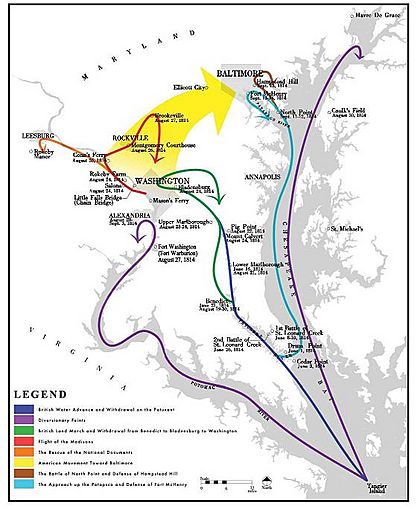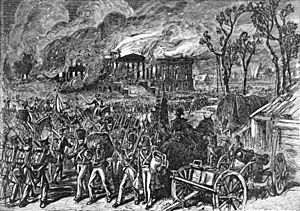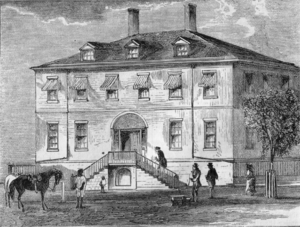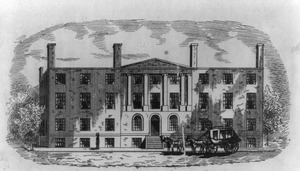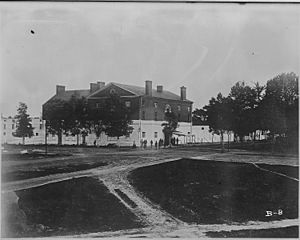Burning of Washington facts for kids
Quick facts for kids Burning of Washington |
|||||||
|---|---|---|---|---|---|---|---|
| Part of the War of 1812 | |||||||
 Burning of Washington, Paul de Thoyras |
|||||||
|
|||||||
| Belligerents | |||||||
| Commanders and leaders | |||||||
| Strength | |||||||
| 4,250 | 7,640 | ||||||
| Casualties and losses | |||||||
| 30 killed 6 wounded |
Unknown killed and wounded 1 frigate destroyed 1 frigate scuttled 1 sloop scuttled |
||||||
The Burning of Washington was a major event during the War of 1812. It happened on August 24, 1814, when British forces attacked and burned parts of Washington, D.C., the capital city of the United States. This was part of the Chesapeake Campaign.
It was the only time since the American Revolutionary War that a foreign country successfully captured and occupied the U.S. capital. After American forces lost the Battle of Bladensburg, British troops marched into Washington. That night, they set fire to many important government buildings. These included the White House (then called the Presidential Mansion) and the Capitol building.
The attack was partly in response to American forces burning and looting the Canadian capital of York (now Toronto) the year before. They also burned buildings in Port Dover. Less than a day after the attack began, a huge thunderstorm, possibly a hurricane, and a tornado helped put out the fires. The British stayed in Washington for about 26 hours.
President James Madison and his government had to leave the city. They found safety in a small town called Brookeville. President Madison stayed at the home of Caleb Bentley. After the storm, the British went back to their ships. Many of their ships needed repairs because of the bad weather.
Contents
Why Did the British Attack Washington?
Britain was already fighting a big war against Napoleon's France when the U.S. declared war in 1812. Most of Britain's soldiers and ships were busy fighting France. At first, Britain mainly blocked U.S. ports by sea and played defense on land. They relied on local Canadian fighters and Native American allies to help their army in Canada.
But in April 1814, Napoleon Bonaparte was defeated. This meant Britain could send more troops and ships to fight the United States. The British leaders decided to attack U.S. coastal cities. This would force American troops away from Canada.
British commanders were told not to go too far inland or try to hold onto land. Vice Admiral Sir Alexander Cochrane was in charge of the Royal Navy in the area. He planned to attack cities like Baltimore, Washington, and New Orleans.
Rear Admiral George Cockburn had been in charge of ships in the Chesapeake Bay. He told Cochrane that U.S. defenses were weak. He thought several major cities could be easily attacked. Cockburn believed that attacking Washington would have a big political impact.
Major General Robert Ross, who led the British army, was not as sure. He didn't think 4,500 soldiers could march 50 miles inland and capture a capital city. Ross also refused to burn the entire city, as Cockburn suggested. He decided to spare most private homes.
Another reason for the attack was revenge. Britain was angry about American forces destroying private property in Canada. For example, U.S. troops had burned buildings in Port Dover. British leaders wanted to get back at the U.S. for these actions.
Some people also thought the attack on Washington was revenge for the American looting of York (now Toronto) in 1813. However, later research suggests this reason was only brought up after the British faced criticism for burning Washington.
On July 18, Cochrane ordered Cockburn to "destroy and lay waste such towns and districts as you may find assailable." He also told him to "spare merely the lives of the unarmed inhabitants."
What Happened During the Attack?
After the Battle of Bladensburg, President James Madison and his government quickly left Washington. They found safety in Brookeville, a small town now known as the "United States' Capital for a Day." President Madison stayed at the home of Caleb Bentley, a Quaker silversmith. Bentley's house, called the Madison House, is still there today.
On August 24, 1814, British troops led by Major General Robert Ross and Rear Admiral George Cockburn attacked the capital. They had about 4,500 experienced soldiers. Ross decided to only damage public buildings, not private homes.
The U.S. Capitol Building
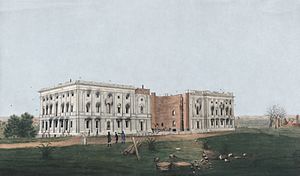
The Capitol building was very important and beautiful. It was a main target for the British. When they arrived, they attacked the Capitol's southern wing (where the House of Representatives met) and then the northern wing (where the Senate met). Before burning it, the British searched the building. At that time, it held Congress, the Library of Congress, and the Supreme Court.
British troops took some items, including a ledger from the President's room. This book was later returned to the Library of Congress in 1940.
The British wanted to burn the Capitol completely. They set fire to the southern wing first. The flames spread so fast that they couldn't gather enough wood to burn the stone walls entirely. However, the books in the Library of Congress in the northern wing helped the fire spread there.
Many valuable items were destroyed, including the Library of Congress's 3,000 books. The wooden ceilings and floors burned, and glass skylights melted from the heat. But the building was not a total loss. Parts like the House rotunda and some staircases survived.
The White House
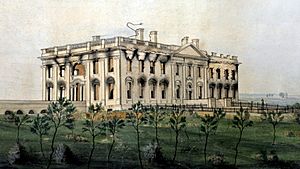
After burning the Capitol, the British moved toward the White House. President Madison and other officials had already left. But First Lady Dolley Madison stayed behind to save important items. She organized staff to help.
Paul Jennings, a 15-year-old who worked for James Madison, saw everything. He later wrote about it. He said that Dolley Madison did not cut out the famous portrait of George Washington. Instead, she took only silver from her bag.
Jennings said that John Susé and Magraw, the President's gardener, saved the painting. They took it down and sent it away on a wagon with other valuable items. When the British arrived, they ate the dinner that had been prepared for the President's party.
The soldiers then burned the President's house. They added more fuel to the fires that night to make sure it kept burning.
In 2009, President Barack Obama honored Paul Jennings's descendants at the White House. They visited and took a family photo in front of the painting their ancestor helped save.
Other Buildings Attacked
The day after the White House was burned, Rear Admiral Cockburn went to the office of the D.C. newspaper, the National Intelligencer. He wanted to burn it down. But some women convinced him not to, fearing the fire would spread to their homes. Cockburn hated the newspaper because it had written bad things about him. Instead, he ordered his troops to tear the building down brick by brick. He also told them to destroy all the "C" type letters so the newspaper couldn't write about him anymore.
The British also searched the U.S. Treasury building for money. They found only old records and burned the building. The United States Department of War building was also burned. However, important files from these departments had been moved to safety.
The First U.S. Patent Office Building was saved. William Thornton, who was in charge of patents, convinced the British to spare it. It was the only government building left untouched in Washington.
Americans had already burned much of the Washington Navy Yard themselves. They did this to stop the British from capturing their supplies, ammunition, and two new ships. Only a few buildings at the Navy Yard survived. The Marine Barracks and Commandant's House were also spared.
On August 25, British soldiers went to a fort on Greenleaf's Point. The Americans had already destroyed the fort, but 150 barrels of gunpowder were left. While the British tried to get rid of the powder, it exploded. About thirty men were killed, and many others were hurt.
The Storm that Saved Washington
Less than a day after the attack began, a sudden, very heavy thunderstorm helped put out the fires. It might have been a hurricane. A tornado also touched down, lifting cannons and killing both British soldiers and American civilians. After the storm, the British troops went back to their ships, many of which were damaged.
Some people believe the storm forced the British to leave. However, it seems their plan was always to destroy the city and then leave, not to stay and occupy it. Commander Robert Ross also did not intend to damage private buildings.
The British stayed in Washington for only about 26 hours. Even though it helped put out fires, the storm also caused more damage. It cracked the already burned walls of the White House and hurt buildings the British hadn't planned to destroy.
One story tells of an encounter between Sir George Cockburn and a woman from Washington. The Admiral asked if this bad weather was normal. The woman replied that it was God's way of driving the enemies from the city. Cockburn said it was helping his enemies destroy the city instead.
The British Navy reported losing one man killed and six wounded in the attack. The total cost of the damage to Washington's public buildings was estimated to be around $40 million in today's money.
While Ross's troops were leaving Washington, a separate British force captured Alexandria, Virginia. The mayor of Alexandria made a deal with the British, and they did not burn the town.
What Happened After the Attack?
President Madison and military officers returned to Washington by September 1. Congress did not return for three and a half weeks. They met in the Post and Patent Office building, which was one of the few large buildings left. Congress met there until December 1815.
Most Americans, even those who were against the war, thought the burning of public buildings was wrong. Many people in Britain were also shocked. Leaders in Europe, where capital cities were often captured but not destroyed, also criticized the British. Some British politicians said the government was making too much of capturing a few buildings in a "non-strategic swamp."
However, many British people felt the burnings were fair revenge. They believed it was payback for the damage American forces had done in Canada. They also argued that the U.S. had started the war. Some saw it as fair revenge for the American destruction of the Parliament buildings in York in 1813.
When the British forces returned to Bermuda, they took two portraits of King George III and Queen Charlotte. These paintings had been found in one of the public buildings. Today, one pair hangs in the Parliament of Bermuda, and the other in the Cabinet Building.
Rebuilding Washington
After the burning, some members of Congress wanted to move the capital. Congressmen from the North wanted to move it to Philadelphia or another northern city. But Southern congressmen argued that moving the capital would make America look weak. They also didn't want the capital to move north. On September 21, the House of Representatives voted against moving the capital from Washington, D.C.
To make sure the capital stayed in Washington, property owners funded a new building called the Old Brick Capitol. This was a larger meeting space where the Supreme Court now stands. Construction began on July 4 and finished in December. Congress met there from December 1815 until the Capitol reopened in December 1819.
Rebuilding the Capitol took much longer than expected. The Old Brick Capitol took only five months, but the Capitol took twelve years. A committee decided it was cheaper to rebuild the damaged buildings than to build new ones. President Madison and Congress approved borrowing $500,000 to repair the public buildings.
Benjamin Henry Latrobe, the architect who had worked on the Capitol before, was hired to repair it. He ordered many materials like boards, stone, and brick. With the borrowed money, Latrobe rebuilt the two wings and the central dome. He was later fired in 1817 due to budget issues.
Charles Bulfinch took over and finished the renovations by 1826. He made the Capitol dome taller. With the public buildings rebuilt, the value of land in Washington increased greatly. This led to the city growing a lot in the years before the American Civil War.
In Literature
The poet Lydia Sigourney wrote a poem about this event called "The Conflagration at Washington" in 1815.
Images for kids
-
Major-General Robert Ross, British commander who led the attack on Washington
-
Portrait of Admiral Cockburn at the National Maritime Museum in Greenwich, with Washington burning in the background. The U.S. Capitol and Treasury Building are at far right.
See also
 In Spanish: Quema de Washington para niños
In Spanish: Quema de Washington para niños


